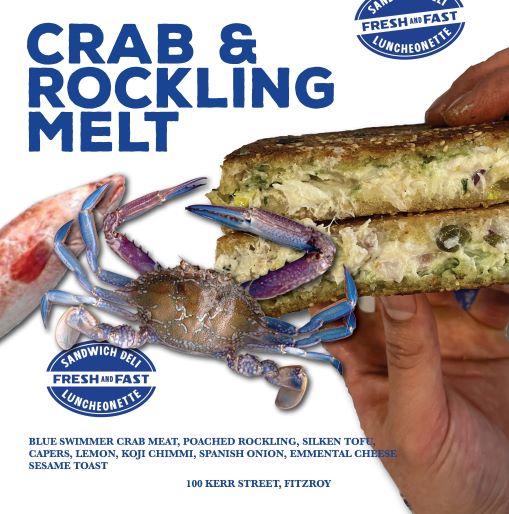The Filet-o-Fish is a polarising sandwich. For some (author included), it conjures a childhood memory of being denied the supreme McDonald’s foodstuff — nuggets. Other are devotees. But most can agree the burger is an exercise in simplicity — steamed bun, white fish, tangy tartare and American cheese — and a blank canvas that can be amplified or dialled down.
Fish sandwiches largely live under the radar in Australia, but they have staple status in the US where variations are found at cafes, diners, seafood-driven restaurants, bars and everything in between. While a little harder to come by here (sans the Golden Arches), the fish sandwich presents an opportunity for chefs to take the bones of a classic to create their own iteration.
Hospitality talks to Baba’s Place’s Director of Flavour Jean-Paul El Tom and Nico’s Sandwich Deli’s Co-Owner and Chef Tom Peasnell about what goes into creating fish sandwiches with fan clubs, accelerating flavour profiles and why they will never be full-time on their menus.
Jean-Paul El Tom is a lifelong fish sandwich fan. It was his favourite burger as a kid, with his dad making his version of samke harra for the future director of flavour. Samke harra translates to spicy fish and goes heavy on the coriander. It can be served on a plate or eaten in sandwich form, which has been the case at Baba’s Place in Sydney’s Marrickville.

“Samke harra varies slightly up and down the coast of Lebanon and Syria has a version, but I grew up on the Tripoli style,” says El Tom. “We’re trying to recreate the memories lived through these dishes.”
El Tom’s iteration of a fish sandwich can be viewed as a Filet-o-Fish meets samke harra. The tastemaker debuted the burger for a fundraiser at Bush in Redfern where it was snapped up in no time. “It sold more than the kofta,” he says. “But I wasn’t so happy with it (I’m never happy with anything); I really wanted to make it a square because otherwise it’s not really a Filet-o-Fish. So we started working on making it a square.”
The shapeshifting mission required a lot of people hours. The entire kitchen team was tasked with making the fish sandwich, which quickly garnered a legion of buyers when it launched in August. “It’s 35 hours of us cutting and layering fish like lasagna — it’s very arduous,” says El Tom. “It’s like a two-day job to get it ready for the week.”
Over in Melbourne, Nico’s rotate their fish sandwiches every couple of weeks. The deli covers three categories of fish sandwiches: melts, fried and grilled.
“We do that because fish has a market price, so we see what we can do and mix it up,” says Tom Peasnell. “We don’t put them on the menu in order to keep the price where we need it. We see what’s at the market and is cheap essentially, but still looking good. The sandwich game is tough because no one wants to buy a sandwich over $20; a lot of people are used to things being at a certain price.

“The other reason we rock them as specials is because they’re not everyone’s go-to in Australia. If we put a fish sandwich on the menu, it will sell equally with a chicken schnitzel on the day it’s available, but if it was permanently on the menu, it would probably be half of the sales.”
Nico’s has a market approach to their fish sandwiches, but recent examples include fried rockling with tartar salad cream-drenched cos and American cheese on country loaf; blue swimmer, poached rockling and tofu sourdough melt with fior di latte and a pan-fried swordfish Turkish panini with rocket and lemon caper vinaigrette.
The fish of choice largely depends on the vessel (the bread). “If we’re doing a sandwich on fresh bread, we look for a hard fish like swordfish or rockling,” says Peasnell. “But if we’re doing a toasted option, we’re using soft, flaky fish like barramundi, whiting or crab meat because toasted bread or a hard roll can wear the moisture and keep it in without turning into a mess.”

Pink ling is Baba’s fish du jour. “It’s a local, sustainable fish that’s underutilised,” says El Tom. “It’s oily and has heaps of moisture; it’s a heavy fish, so it cops the heat. The square gets really cooked in the fryer.”
Baba’s brigade takes fresh fillets of pink ling and slices them in a way that could be likened to sashimi. “We cut long strips lengthways with the muscle fibre,” says El Tom. The fish is then layered in line with a gratin “but with fish” before it heads into the freezer. “After you freeze it, it’s shaped into a square and then frozen again. We crumb it the next day in panko and it’s fried in cottonseed oil.”
If hand-forming pink ling patties wasn’t labour-intensive enough, the chimichurri element is the cherry on top. “One batch of the chimi got us through half a day and it was made from 14 bunches of coriander, eight bunches of parsley and eschallots,” says El Tom. “It’s hard because you have to pull heaps of moisture out of the herbs. Everything about it is intense.”
The chimichurri’s flavour profile sings the high note in the burger, but it’s mellowed out with the addition of a tahini tartare. “It’s pretty much mayo, but it’s built into a tartare,” says El Tom.
American cheese is the final ingredient inside the potato bun, ensuring the burger sticks to the original influence’s straightforward composition: it’s all about the fish. “It’s a thick piece of fish — you really taste it and that’s what we’re showcasing; fresh, Aussie fish,” says El Tom. “Fish has been treated like, ‘Let’s turn this into something that doesn’t look or taste like fish and people will like it’, which is fish’s clout. But if you get good fish and treat it nicely, it’s super tasty.”
Nico’s fish sandwiches all require different techniques. For fried fish options, ‘steadier’ cuts including rockling are coated in a gluten-free soda water/honey/vodka batter with potato starch, tapioca or rice flour. Or, they’re given the egg wash and panko treatment for a schnitzel-esque product. “There are certain fish that work really well for frying because they hold themselves in for a nice-looking sandwich, so swordfish and rockling are the ones we tend to use,” says Peasnell.
The fish is fried to order in a blend of sunflower and canola oils selected for a high smoke point. “We can hold the fryer really high around 200 degrees Celsius and the oil won’t turn,” says the chef. “You want a crisp exterior while not drying out the fish, so we fry for around two and a half minutes and let the residual heat of the batter finish cooking it.”
To create the blue swimmer crab melt, the meat is combined with rockling and silken tofu to set the protein element. The combination lends itself to a toasted application, with the kitchen slathering the bread with the bones of the sandwich (fish, butter, cheese) before refrigerating. “We put the same butter on every sandwich which is a koji chimichurri through a house-made butter,” says Peasnell. “It’s there for brightness and to protect the bread, so when we add a fat element, none of the moisture gets soaked into it.”

Once the melt has been set overnight, it’s toasted from cold before fresh ingredients like salads are added in. “You just warm it through the middle so it gets that gooeyness back, but it’s not spilling out everywhere and too soft,” says Peasnell.
A grilled option is a more straightforward affair, with the fish going straight into bread from the grill before it’s topped with salad.
Fish sandwiches have been a smash hit at Baba’s Place, with some customers choosing to leave empty-handed when they realised it was sold out for the day. It was nice while it lasted, but the kitchen made the call to take it off the menu. “It was occupying too much time; we weren’t able to test and develop other dishes,” says El Tom. “We had so much time to do other stuff when we took it off. I think it will come back at some point.”
Nico’s will continue to offer a fish sandwich every couple of weeks, with the warmer weather bringing in the buyers who just might swap their schnitty for an option that won’t be sticking around. “People know they can only get it for a short time,” says Peasnell. “So they will order it and it makes it a bit special.” And who doesn’t love that special feeling?
Sponsored Content

Discover Dairy Farmers’ range of shredded cheese
Sponsored by Bega

Beachfront Melbourne Club catering & restaurant opportunity
Sponsored by Future Food
Trending Now
Resources
Lorem ipsum dolor sit amet, consectetur adipiscing elit. Fusce ac ornare lectus. Sed bibendum lobortis...
Lorem ipsum dolor sit amet, consectetur adipiscing elit. Fusce ac ornare lectus. Sed bibendum lobortis...
Sign up for our newsletter
